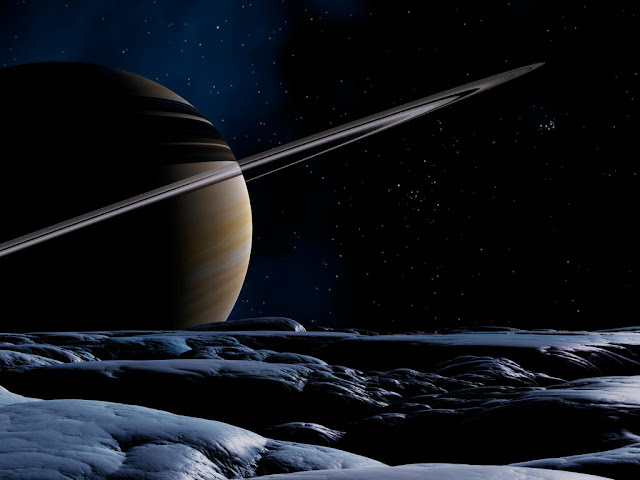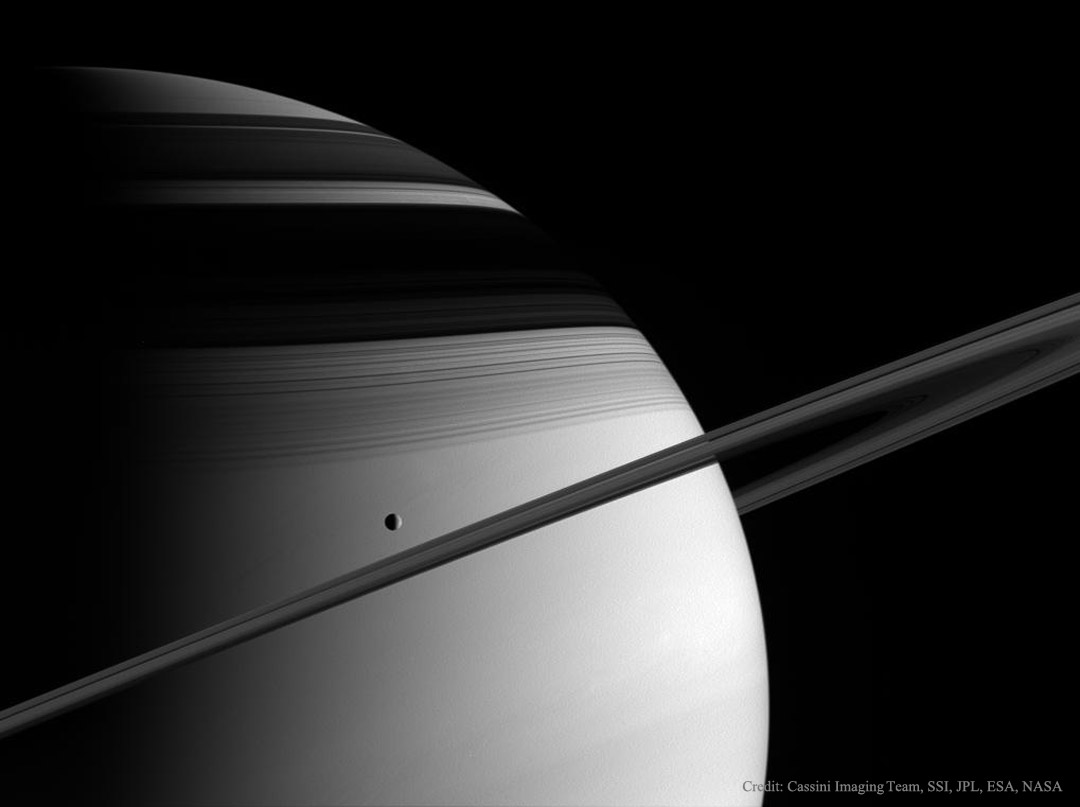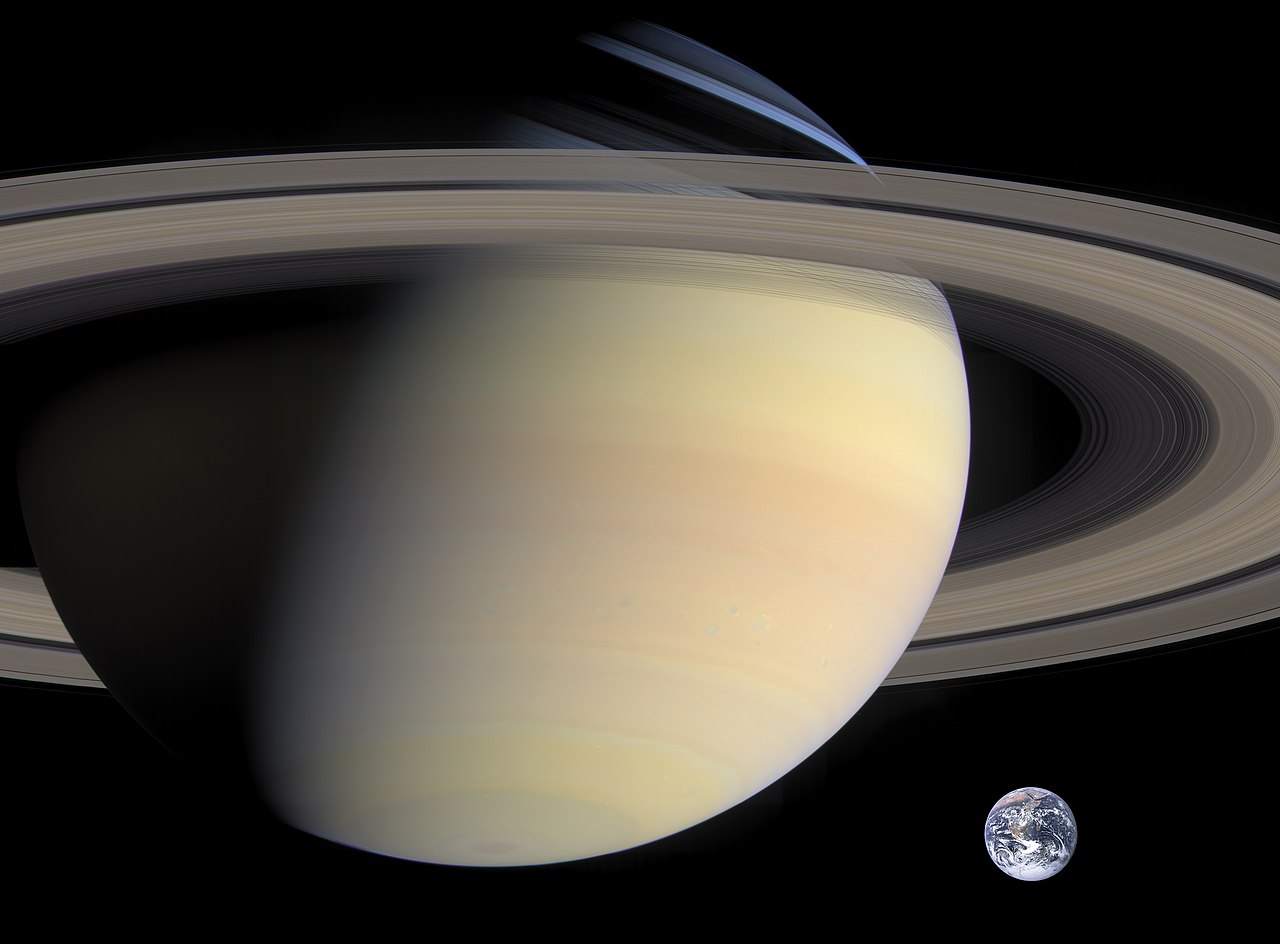Comments and questions about the
APOD on the main view screen.
-
APOD Robot
- Otto Posterman
- Posts: 5467
- Joined: Fri Dec 04, 2009 3:27 am
-
Contact:
Post
by APOD Robot » Sun Jan 23, 2022 5:06 am
 Saturn, Tethys, Rings, and Shadows
Explanation:
Saturn, Tethys, Rings, and Shadows
Explanation: Seen from
ice moon Tethys, rings and shadows would display fantastic views of the Saturnian system. Haven't
dropped in on Tethys lately? Then
this gorgeous ringscape from the Cassini spacecraft will have to do for now. Caught
in sunlight just below and left of picture center in 2005, Tethys itself is about 1,000 kilometers in diameter and orbits not quite
five saturn-radii from the center of the gas giant planet. At that distance (around 300,000 kilometers) it is well outside Saturn's
main bright rings, but Tethys is still
one of five major moons that find themselves within the boundaries of the faint and tenuous outer
E ring. Discovered in the 1980s, two very small moons
Telesto and
Calypso are locked in stable
along Tethys' orbit. Telesto precedes and Calypso
follows Tethys as the trio
circles Saturn.
-
Ann
- 4725 Å
- Posts: 13629
- Joined: Sat May 29, 2010 5:33 am
Post
by Ann » Sun Jan 23, 2022 11:33 am
Where have I seen the picture that is today's APOD before? And why am I so disappointed that it is not in color?
Oh yes! Today's APOD resembles a beautiful picture of Saturn and the Earth, where the northern hemisphere of Saturn looks blue!

Ann
Color Commentator
-
VictorBorun
- Captain
- Posts: 1089
- Joined: Fri Oct 16, 2020 10:25 pm
-
Contact:
Post
by VictorBorun » Sun Jan 23, 2022 12:02 pm
yeah, Saturn is colorful in a saturated pic
Sadly its rings are not.
-
orin stepanek
- Plutopian
- Posts: 8200
- Joined: Wed Jul 27, 2005 3:41 pm
- Location: Nebraska
Post
by orin stepanek » Sun Jan 23, 2022 1:18 pm
Tethys looking lonely here!
By looking where the cracks are and where they are not. Is it
possible that Enceladus may have continents?

Rescue dog saving kitty!

Orin
Smile today; tomorrow's another day!
-
johnnydeep
- Commodore
- Posts: 3045
- Joined: Sun Feb 20, 2011 8:57 pm
Post
by johnnydeep » Sun Jan 23, 2022 3:15 pm
APOD Robot wrote: ↑Sun Jan 23, 2022 5:06 am
 Saturn, Tethys, Rings, and Shadows
Explanation:
Saturn, Tethys, Rings, and Shadows
Explanation: Seen from
ice moon Tethys, rings and shadows would display fantastic views of the Saturnian system. Haven't
dropped in on Tethys lately? Then
this gorgeous ringscape from the Cassini spacecraft will have to do for now. Caught
in sunlight just below and left of picture center in 2005, Tethys itself is about 1,000 kilometers in diameter and orbits not quite
five saturn-radii from the center of the gas giant planet. At that distance (around 300,000 kilometers) it is well outside Saturn's
main bright rings, but Tethys is still
one of five major moons that find themselves within the boundaries of the faint and tenuous outer
E ring. Discovered in the 1980s, two very small moons
Telesto and
Calypso are locked in stable along Tethys' orbit. Telesto precedes and Calypso
follows Tethys as the trio
circles Saturn.
...are locked in [a] stable Lagrange configuration?
--
"To B̬̻̋̚o̞̮̚̚l̘̲̀᷾d̫͓᷅ͩḷ̯᷁ͮȳ͙᷊͠ Go......Beyond The F͇̤i̙̖e̤̟l̡͓d͈̹s̙͚ We Know."{ʲₒʰₙNYᵈₑᵉₚ}
-
XgeoX
- Science Officer
- Posts: 215
- Joined: Tue Jun 30, 2020 12:57 pm
- AKA: Uncle Rico
Post
by XgeoX » Sun Jan 23, 2022 3:33 pm
A little different view…

So cold and lonely yet so beautiful…
Eric
Ego vigilate
Ego audire
-
revloren
- Ensign
- Posts: 47
- Joined: Thu Jun 30, 2011 4:07 pm
- Location: Agrestic Village
Post
by revloren » Sun Jan 23, 2022 3:40 pm
Fascinating how the shadow of the rings appears as a wavy line. A curved surface projected on another curved surface!
-
johnnydeep
- Commodore
- Posts: 3045
- Joined: Sun Feb 20, 2011 8:57 pm
Post
by johnnydeep » Sun Jan 23, 2022 3:48 pm
XgeoX wrote: ↑Sun Jan 23, 2022 3:33 pm
A little different view…

So cold and lonely yet so beautiful…
Eric
I really like this image. Where did it come from?
--
"To B̬̻̋̚o̞̮̚̚l̘̲̀᷾d̫͓᷅ͩḷ̯᷁ͮȳ͙᷊͠ Go......Beyond The F͇̤i̙̖e̤̟l̡͓d͈̹s̙͚ We Know."{ʲₒʰₙNYᵈₑᵉₚ}
-
XgeoX
- Science Officer
- Posts: 215
- Joined: Tue Jun 30, 2020 12:57 pm
- AKA: Uncle Rico
Post
by XgeoX » Sun Jan 23, 2022 3:54 pm
orin stepanek wrote: ↑Sun Jan 23, 2022 1:18 pm
By looking where the cracks are and where they are not. Is it
possible that Enceladus may have continents?

Not in the sense Earth does as Tethys has a active ice mantle but it doesn’t really behave like Earth’s molten mantle and how it generates a separate crust. Scientists are still trying to decode if Enceladus has a “stagnant” or “mobile” lid. If it’s mobile then it could drive movement that looks like Earth’s plate tectonics but is actually quite different.
I got that information from Saturn Cat!

Eric
Last edited by
XgeoX on Mon Jan 24, 2022 1:00 pm, edited 1 time in total.
Ego vigilate
Ego audire
-
XgeoX
- Science Officer
- Posts: 215
- Joined: Tue Jun 30, 2020 12:57 pm
- AKA: Uncle Rico
Post
by XgeoX » Sun Jan 23, 2022 3:58 pm
johnnydeep wrote: ↑Sun Jan 23, 2022 3:48 pm
XgeoX wrote: ↑Sun Jan 23, 2022 3:33 pm
A little different view…

So cold and lonely yet so beautiful…
Eric
I really like this image. Where did it come from?
I do too! I just do web searches for space art. Here is the web site…
https://ralf-schoofs.blogspot.com/2012 ... aturn.html.
Have fun, lots of great stuff out there!

Eric
Ego vigilate
Ego audire
-
johnnydeep
- Commodore
- Posts: 3045
- Joined: Sun Feb 20, 2011 8:57 pm
Post
by johnnydeep » Sun Jan 23, 2022 4:30 pm
XgeoX wrote: ↑Sun Jan 23, 2022 3:58 pm
johnnydeep wrote: ↑Sun Jan 23, 2022 3:48 pm
XgeoX wrote: ↑Sun Jan 23, 2022 3:33 pm
A little different view…

So cold and lonely yet so beautiful…
Eric
I really like this image. Where did it come from?
I do too! I just do web searches for space art. Here is the web site…
https://ralf-schoofs.blogspot.com/2012 ... aturn.html.
Have fun, lots of great stuff out there!

Eric
Thanks! That link hints at there being a 10000 x 7500 px original, but only seems to show one that's 1024 x 768.
--
"To B̬̻̋̚o̞̮̚̚l̘̲̀᷾d̫͓᷅ͩḷ̯᷁ͮȳ͙᷊͠ Go......Beyond The F͇̤i̙̖e̤̟l̡͓d͈̹s̙͚ We Know."{ʲₒʰₙNYᵈₑᵉₚ}
-
alter-ego
- Serendipitous Sleuthhound
- Posts: 1121
- Joined: Mon Apr 21, 2008 4:51 am
- Location: Redmond, WA
Post
by alter-ego » Sun Jan 23, 2022 5:31 pm
johnnydeep wrote: ↑Sun Jan 23, 2022 3:15 pm
APOD Robot wrote: ↑Sun Jan 23, 2022 5:06 am
 Saturn, Tethys, Rings, and Shadows
Explanation:
Saturn, Tethys, Rings, and Shadows
Explanation: Seen from
ice moon Tethys, rings and shadows would display fantastic views of the Saturnian system. Haven't
dropped in on Tethys lately? Then
this gorgeous ringscape from the Cassini spacecraft will have to do for now. Caught
in sunlight just below and left of picture center in 2005, Tethys itself is about 1,000 kilometers in diameter and orbits not quite
five saturn-radii from the center of the gas giant planet. At that distance (around 300,000 kilometers) it is well outside Saturn's
main bright rings, but Tethys is still
one of five major moons that find themselves within the boundaries of the faint and tenuous outer
E ring. Discovered in the 1980s, two very small moons
Telesto and
Calypso are locked in stable along Tethys' orbit. Telesto precedes and Calypso
follows Tethys as the trio
circles Saturn.
...are locked in [a] stable Lagrange configuration?
Yes.
https://solarsystem.nasa.gov/resources/12393/telesto-companion-of-tethys/ wrote:
Telesto (24 kilometers, or 15 miles across) shares the orbit of Saturn's moon Tethys (1,071 kilometers, or 665 miles across), leading the larger moon in its path by 60 degrees. Similarly sized Calypso (22 kilometers, or 14 miles across) trails Tethys by the same amount. These positions, called Lagrange points, are dynamically stable. In being co-orbital moons of Tethys, Telesto and Calypso are like the Trojan moons of Jupiter, which occupy Lagrange points and orbit 60 degrees ahead and behind of Jupiter. The Saturnian moon Dione also has companion moons: Helene, which leads Dione in its orbit, and the Cassini-discovered trailing Lagrange moon, Polydeuces.
A pessimist is nothing more than an experienced optimist
-
neufer
- Vacationer at Tralfamadore
- Posts: 18805
- Joined: Mon Jan 21, 2008 1:57 pm
- Location: Alexandria, Virginia
Post
by neufer » Sun Jan 23, 2022 6:07 pm
alter-ego wrote: ↑Sun Jan 23, 2022 5:31 pm
https://solarsystem.nasa.gov/resources/12393/telesto-companion-of-tethys/ wrote:
Telesto (24 kilometers, or 15 miles across) shares the orbit of Saturn's moon Tethys (1,071 kilometers, or 665 miles across), leading the larger moon in its path by 60 degrees. Similarly sized Calypso (22 kilometers, or 14 miles across) trails Tethys by the same amount. These positions, called Lagrange points, are dynamically stable. In being co-orbital moons of Tethys, Telesto and Calypso are like the Trojan moons of Jupiter, which occupy Lagrange points and orbit 60 degrees ahead and behind of Jupiter. The Saturnian moon Dione also has companion moons: Helene, which leads Dione in its orbit, and the Cassini-discovered trailing Lagrange moon, Polydeuces.
Note that Tethys & Dione are also in 1:2 orbital resonances with the inner moons: Mimas & Enceladus, respectively.
These two orbital resonances helps to maintain the inner moons' eccentricities which result in:
- 1) Mimas clearing out a wide Cassini Division ring gap and
2) Enceladus spewing out south polar plumes at apoapsis
Art Neuendorffer
-
Ann
- 4725 Å
- Posts: 13629
- Joined: Sat May 29, 2010 5:33 am
Post
by Ann » Sun Jan 23, 2022 9:01 pm
XgeoX wrote: ↑Sun Jan 23, 2022 3:33 pm
A little different view…

So cold and lonely yet so beautiful…
Eric
Very beautiful. Please note the Pleiades (and the Hyades) in the background.
Ann
Color Commentator
-
MarkBour
- Subtle Signal
- Posts: 1377
- Joined: Mon Aug 26, 2013 2:44 pm
- Location: Illinois, USA
Post
by MarkBour » Sun Jan 23, 2022 10:35 pm
neufer wrote: ↑Sun Jan 23, 2022 6:07 pm
alter-ego wrote: ↑Sun Jan 23, 2022 5:31 pm
https://solarsystem.nasa.gov/resources/12393/telesto-companion-of-tethys/ wrote:
Telesto (24 kilometers, or 15 miles across) shares the orbit of Saturn's moon Tethys (1,071 kilometers, or 665 miles across), leading the larger moon in its path by 60 degrees. Similarly sized Calypso (22 kilometers, or 14 miles across) trails Tethys by the same amount. These positions, called Lagrange points, are dynamically stable. In being co-orbital moons of Tethys, Telesto and Calypso are like the Trojan moons of Jupiter, which occupy Lagrange points and orbit 60 degrees ahead and behind of Jupiter. The Saturnian moon Dione also has companion moons: Helene, which leads Dione in its orbit, and the Cassini-discovered trailing Lagrange moon, Polydeuces.
Note that Tethys & Dione are also in 1:2 orbital resonances with the inner moons: Mimas & Enceladus, respectively.
These two orbital resonances helps to maintain the inner moons' eccentricities which result in:
- 1) Mimas clearing out a wide Cassini Division ring gap and
2) Enceladus spewing out south polar plumes at apoapsis
Interesting. I wonder if the three moons, Telesto, Tethys and Calypso also induce some more complex points of stability where other smaller objects are held? Telesto and Calypso are big enough that they're perturbing Tethys as well. Or, perhaps the three are "cleaning out" the rest of the objects in the orbit.
Cassini would be a top contender for "greatest photographer of the solar system" ... even in black-and-white.
Mark Goldfain
-
neufer
- Vacationer at Tralfamadore
- Posts: 18805
- Joined: Mon Jan 21, 2008 1:57 pm
- Location: Alexandria, Virginia
Post
by neufer » Sun Jan 23, 2022 11:28 pm
MarkBour wrote: ↑Sun Jan 23, 2022 10:35 pm
Telesto and Calypso are big enough that they're perturbing Tethys as well.
Saturn's mass is ~6 orders of magnitude greater than that of Tethys.
Tethys's mass is ~5 orders of magnitude greater than that of Telesto or Calypso.
Art Neuendorffer
-
MarkBour
- Subtle Signal
- Posts: 1377
- Joined: Mon Aug 26, 2013 2:44 pm
- Location: Illinois, USA
Post
by MarkBour » Mon Jan 24, 2022 2:44 am
neufer wrote: ↑Sun Jan 23, 2022 11:28 pm
MarkBour wrote: ↑Sun Jan 23, 2022 10:35 pm
Telesto and Calypso are big enough that they're perturbing Tethys as well.
Saturn's mass is ~6 orders of magnitude greater than that of Tethys.
Tethys's mass is ~5 orders of magnitude greater than that of Telesto or Calypso.
Okay, so you're suggesting insignificant to the orbital mechanics of Tethys. I see I was misinterpreting your plot, which turns out to be about Helene, Dione, and Polydeuces.
Mark Goldfain
 Saturn, Tethys, Rings, and Shadows
Saturn, Tethys, Rings, and Shadows




